Apple iPhone 4S: Thoroughly Reviewed
by Anand Lal Shimpi & Brian Klug on October 31, 2011 7:45 PM EST- Posted in
- Smartphones
- Apple
- Mobile
- iPhone
- iPhone 4S
Display
Though many expected Apple to redesign everything around a 4“ display, the display on the 4S superficially identical. The 4S includes the same size and resolution display as the 4, namely a 3.54” IPS panel with 960x640 resolution. We’ve been over this a few times already in the context of the iPhone 4 and the CDMA iPhone 4, but it bears going over again.
In retrospect, moving up to 4“ would’ve gone against Apple’s logical approach to maintaining a DPI-agnostic iOS, and it makes sense to spread the cost of changing display resolution across two generations, which is what we see now. While Android is gradually catching up in the DPI department, OEMs on that side of the fence are engaged in a seemingly endless battle over display size. You have to get into Apple’s head and understand that from their point of view, 3.5” has always been the perfect size - there’s a reason it hasn’t changed at all.
I’ve been through a few 4s myself, and alongside the CDMA iPhone 4, have seen the white point of the retina display gradually shift over time. While I don’t have that original device anymore, even now the 4S seems to have shifted slightly compared to a very recently manufactured 4 I had on hand, and appears to have a different color temperature. We’ve been measuring brightness and white point on smartphone displays at a variety of different brightness settings, and the 4S isn’t spared the treatment. I also tossed in my 4 for comparison purposes. The data really speaks for itself.

The first chart shows white point at a number of brightness values set in settings. You can see the iPhone 4 and 4S differ and straddle opposite sides of 6500K. I would bet that Apple has some +/- tolerance value for these displays from 6500K, and the result is what you see here. Thankfully the lines are pretty straight (so it doesn’t change as you vary brightness), but this variance is why you see people noting that one display looks warmer or cooler than the other. I noted this behavior with the CDMA iPhone 4, and suspect that many people still carrying around launch GSM/UMTS iPhone 4 devices will perceive the difference more than those who have had their devices swapped.
The next two charts show display brightness at various settings for solid black and white on the display.
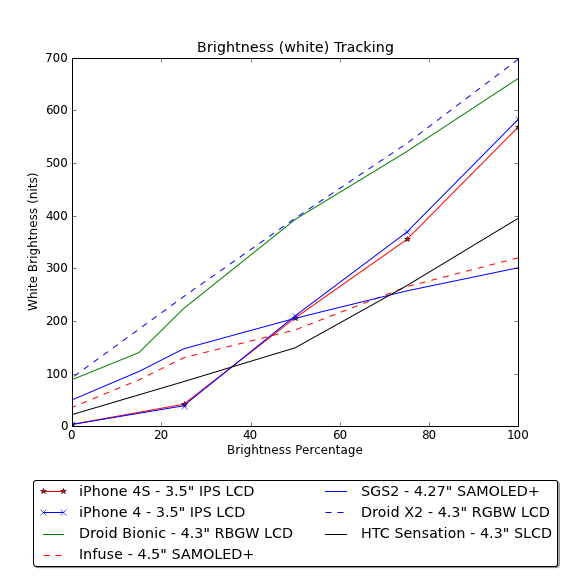
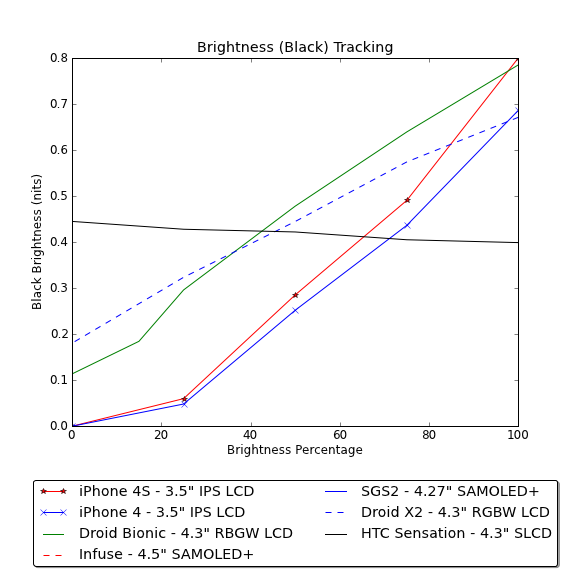
The 4S and 4 displays follow roughly the same curve, however there is a definite shift in contrast resulting from higher black levels on the 4S display. I’ve seen a few anecdotal accounts of the 4S display being less contrasty, and again this is the kind of shift that unfortunately happens over time with displays. I’ve updated our iPhone 4 result on the graph with the latest of a few I’ve been through.
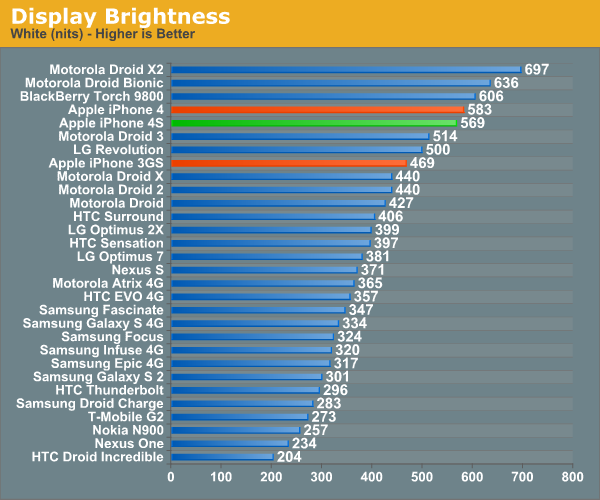
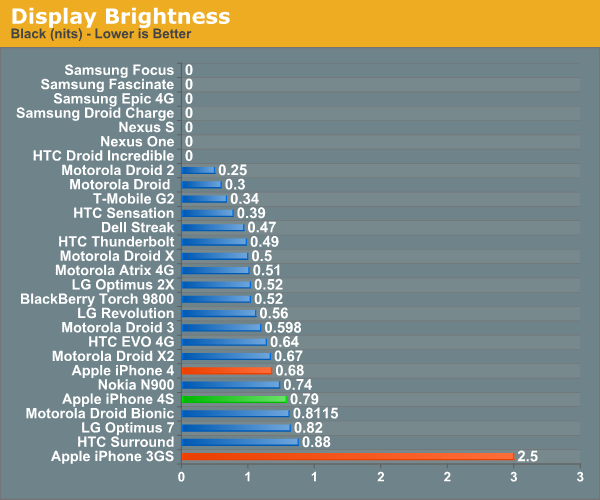
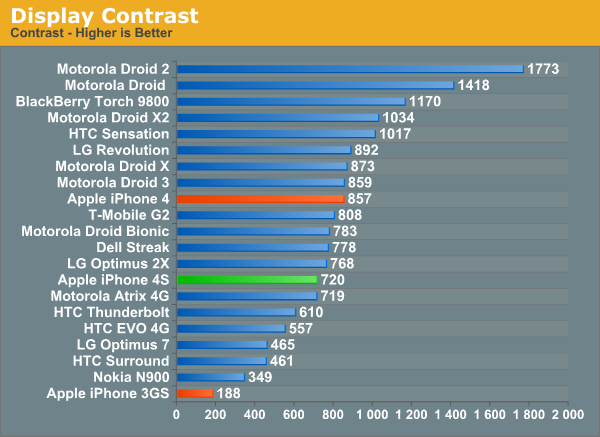
Unfortunately the 4S falls short of the quoted 800:1 contrast ratio, whereas the 4 previously well exceeded it (the earliest 4 we saw had a contrast value of 951). Rumor has it that Apple has approved more panel vendors to make the retina display, I have no doubt that we’re seeing these changes in performance as a result of multiple sourcing.










199 Comments
View All Comments
robco - Monday, October 31, 2011 - link
I've been using the 4S from launch day and agree that Siri needs some work. That being said, it's pretty good for beta software. I would imagine Apple released it as a bonus for 4S buyers, but also to keep the load on their servers small while they get some real-world data before the final version comes in an update.The new camera is great. As for me, I'm glad Apple is resisting the urge to make the screen larger. The Galaxy Nexus looks nice, but the screen will be 4.65". I want a smartphone, not a tablet that makes phone calls. I honestly wouldn't want to carry something much larger than the iPhone and I would imagine I'm not the only one.
Great review as always.
TrackSmart - Monday, October 31, 2011 - link
I'm torn on screen size myself. Pocketable is nice. But I'm intrigued by the idea of a "mini-tablet" form factor, like the Samsung Galaxy Note with it's 5.3" screen (1280x800 resolution) and almost no bezel. That's HUGE for a phone, but if it replaces a tablet and a phone, and fits my normal pants pockets, it would be an interesting alternative. The pen/stylus is also intriguing. I will be torn between small form factor vs mini-tablet when I make my phone upgrade in the near future.To Anand and Brian: I'd love to see a review of the Samsung Galaxy Note. Maybe Samsung can send you a demo unit. It looks like a refined Dell Streak with a super-high resolution display and Wacom digitizer built in. Intriguing.
Rick83 - Wednesday, November 2, 2011 - link
That's why I got an Archos 5 two years ago. And what can I say? It works.Sadly the Note is A) three times as expensive as the Archos
and B) not yet on Android 4
there's also C) Codec support will suck compared to the Archos, and I'm pretty sure Samsung won't release an open bootloader, like Archos does.
I'm hoping that Archos will soon release a re-fresh of their smaller size tablets base on OMAP 4 and Android 4.
Alternatively, and equally as expensive as the Note, is the Sony dual-screen tablet. Looks interesting, but same caveats apply....
kylecronin - Monday, October 31, 2011 - link
> It’s going to be a case by case basis to determine which 4 cases that cover the front of the display work with the 4S.Clever
metafor - Monday, October 31, 2011 - link
"Here we have two hypothetical CPUs, one with a max power draw of 1W and another with a max power draw of 1.3W. The 1.3W chip is faster under load but it draws 30% more power. Running this completely made-up workload, the 1.3W chip completes the task in 4 seconds vs. 6 for its lower power predecessor and thus overall power consumed is lower. Another way of quantifying this is to say that in the example above, CPU A does 5.5 Joules of work vs. 6.2J for CPU B."The numbers are off. 4 seconds vs 6 seconds isn't 30% faster. Time-to-complete is the inverse of clockspeed.
Say a task takes 100 cycles. It would take 1 second on a 100Hz, 1 IPC CPU and 0.77 seconds on a 130Hz, 1 IPC CPU. This translates to 4.62 sec if given a task that takes 600 cycles of work (6 sec on the 100Hz, 1 IPC CPU).
Or 1W * 6s = 6J = 1.3W * 4.62s
Exactly the same amount of energy used for the task.
Anand Lal Shimpi - Monday, October 31, 2011 - link
Err sorry, I should've clarified. For the energy calculations I was looking at the entire period of time (10 seconds) and assumed CPU A & B have the same 0.05W idle power consumption.Doing the math that way you get 1W * 6s + 0.05W * 4s = 6.2J (CPU B)
and
1.3W * 4s + 0.05W * 6s = 5.5J (CPU A)
metafor - Monday, October 31, 2011 - link
Erm, that still presents the same problem. That is, a processor running at 130% the clockspeed will not finish in 4 seconds, it will finish in 4.62s.So the result is:
1W * 6s + 0.05W * 4s = 6.2J (CPU B)
1.3W * 4.62s + 0.05 * 5.38s = 6.275J (CPU A)
There's some rounding error there. If you use whole numbers, say 200Hz vs 100Hz:
1W * 10s + 0.05W * 10s = 10.5W (CPU B running for 20s with a task that takes 1000 cycles)
2W * 5s + 0.05W * 15s = 10.75W (CPU A running for 10s with a task that takes 1000 cycles)
Anand Lal Shimpi - Monday, October 31, 2011 - link
I wasn't comparing clock speeds, you have two separate processors - architectures unknown, 100% hypothetical. One draws 1.3W and completes the task in 4s, the other draws 1W and completes in 6s. For the sake of drawing a parallel to the 4S vs 4 you could assume that both chips run at the same clock. The improvements are entirely architectural, similar to A5 vs. A4.Take care,
Anand
metafor - Tuesday, November 1, 2011 - link
In that case, the CPU that draws 1.3W is more power efficient, as it managed to gain a 30% power draw for *more* than a 30% performance increase.I absolutely agree that this is the situation with the A5 compared to the A4, but that has nothing to do with the "race to sleep" problem.
That is to say, if CPU A finishes a task in 4s and CPU B finishes a task in 6s. CPU A is more than 30% faster than CPU B; it has higher perf/W.
Anand Lal Shimpi - Tuesday, November 1, 2011 - link
It is race to sleep though. The more power efficient CPU can get to sleep quicker (hurry up and wait is what Intel used to call it), which offsets any increases in peak power consumption. However, given the right workload, the more power efficient CPU can still use more power.Take care,
Anand